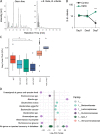Mucin-derived O-glycans supplemented to diet mitigate diverse microbiota perturbations
- PMID: 33087860
- PMCID: PMC8027378
- DOI: 10.1038/s41396-020-00798-6
Mucin-derived O-glycans supplemented to diet mitigate diverse microbiota perturbations
Abstract
Microbiota-accessible carbohydrates (MACs) are powerful modulators of microbiota composition and function. These substrates are often derived from diet, such as complex polysaccharides from plants or human milk oligosaccharides (HMOs) during breastfeeding. Host-derived mucus glycans on gut-secreted mucin proteins serve as a continuous endogenous source of MACs for resident microbes; here we investigate the potential role of purified, orally administered mucus glycans in maintaining a healthy microbial community. In this study, we liberated and purified O-linked glycans from porcine gastric mucin and assessed their efficacy in shaping the recovery of a perturbed microbiota in a mouse model. We found that porcine mucin glycans (PMGs) and HMOs enrich for taxonomically similar resident microbes. We demonstrate that PMGs aid recovery of the microbiota after antibiotic treatment, suppress Clostridium difficile abundance, delay the onset of diet-induced obesity, and increase the relative abundance of resident Akkermansia muciniphila. In silico analysis revealed that genes associated with mucus utilization are abundant and diverse in prevalent gut commensals and rare in enteric pathogens, consistent with these glycan-degrading capabilities being selected for during host development and throughout the evolution of the host-microbe relationship. Importantly, we identify mucus glycans as a novel class of prebiotic compounds that can be used to mitigate perturbations to the microbiota and provide benefits to host physiology.
Conflict of interest statement
KMP, AM, AMS, DD, SAS, SKH, EDS, PCK, BC, LB, no conflicts of interest. JAF is a scientist at NGM Biopharmaceuticals. JLS is a founder of Novome Biotechnologies, Inc., Gnubiotics has licensed intellectual property related to this manuscript.
Figures





References
-
- Sonnenburg JL, Xu J, Leip DD, Chen C-H, Westover BP, Weatherford J, et al. Glycan foraging in vivo by an intestine-adapted bacterial symbiont. Science. 2005;307:1955–9. - PubMed
Publication types
MeSH terms
Substances
Grants and funding
LinkOut - more resources
Full Text Sources
Miscellaneous

